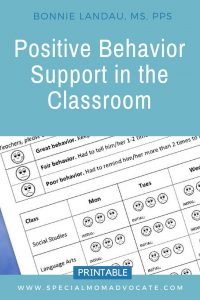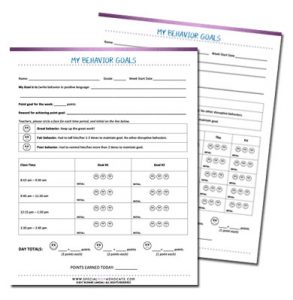 Behavior support in a general ed classroom is often one of the more challenging pieces to get into place for a student. While teachers very much want to help their kids, most teachers these days have overfull classes and many students who need special attention.
Behavior support in a general ed classroom is often one of the more challenging pieces to get into place for a student. While teachers very much want to help their kids, most teachers these days have overfull classes and many students who need special attention.
While working as a school counselor, I found the teachers would often turn to the counselors for help. Often the student did not have an IEP, and the teacher needed to put supports in place while waiting for that process to happen. As a parent, you can request using a support system like this. If your child has an IEP, you can even call an IEP meeting and ask to have it added to their plan. Using a behavior support sheet is a great way to help a student improve by focusing on one or two behaviors at a time.
Behavior Support Sheets for Different Ages
I have created two Word documents with two versions of a behavior support sheet.
- One is for an elementary student who is with the same teacher all day.
- The second is for a middle or high school student who is with 6 teachers each day.
Both sheets are editable Word documents, so you can add custom information or class names.
How do you use a behavior support sheet?
- Identify one or two behaviors that need improving.

- Write the behavior in positive language. For example, if the child talks a lot in class, you would write “Child will stay quiet in class” instead of “Child will not talk in class.”
- Explain to the student that when they engage in the positive behavior, they will get a happy face on the sheet. If they need reminding to do the behavior, they will get a neutral or sad face, depending on the number of reminders.
- Choose a reward the student will get if they achieve a certain number of points. The reward could be more free time, a homework pass or even small trinkets if you feel it is appropriate.
- For elementary students, use one behavior sheet per day. Separate out chunks of the day so a student has more opportunities to feel successful. At the end of the day, add the points for the faces circled and calculate the total. Have the student review the sheet with the teacher.
- For middle or high school students, use one sheet per week. At the end of the week, add the points for happy faces circled. Have the student review the sheet with the case manager or school counselor.
- If the student has achieved the goal points, they will receive the previously decided reward. For elementary students they do not have to receive a daily award, but can accumulate points for a reward once or twice a week. You need to use your judgment on how long the child can wait on a reward as some students reinforcement more often.
ABOUT THE AUTHOR:
Bonnie Landau is a professional counselor and holistic therapist in Ventura County, California. Her specialities include therapy for autism, therapy for ADHD, and therapy for parenting who have kids with autism or ADHD or other neurodivergence. She changed careers from graphic design to counseling with the goal of helping struggling parents of kids with ADHD, autism, or other neurodivergence find strategies and solutions to help their children succeed. Bonnie is also the author of Special Ed Mom Survival Guide: How to Prevail in the Special Education Process and Find Life-long Strategies for You and Your Child.


